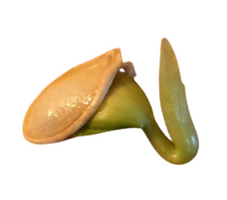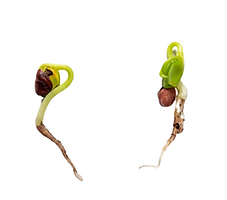


Crop Swap LA™ - Mystery Seed Packets
Crop Swap LA is now offering exclusive Mystery Seed Packets! Each packet contains a carefully curated selection of in-season seeds to bring to your home growing space. Each packet includes a surprise assortment of vibrant flowers, culinary herbs, and nutritious vegetables, perfect to add to your new or existing garden. Whether you're a seasoned producer or just starting out, these packets promise a fruitful journey of learning and green-thumb satisfaction!
Allow your inner farmer to sprout and let nature surprise you. Order your Mystery Seed Packets today and watch your garden flourish with the magic of the unknown. Happy planting!
Care Instructions
-
Place seeds on top of a damp paper towel, cover them with a plastic bag, and let them sit for one week
-
Plant sprouted seeds in soil mixture about ¼ inch below the surface
-
Check cropswapla.org/mysteryseeds to see what seeds you’re growing!
-
Water each plant according to the information provided on the website
-
Check plant regularly for aphids and other pests
-
Harvest responsibly and enjoy!
Current Seed Varieties
Butternut Squash
-
This is a warm-season crop. Wait until the danger of frost has passed and the soil temperature is consistently above 60°F (15°C) before planting.
-
Incorporate organic matter like compost to improve soil health
-
Keep the soil consistently moist. We recommend deep, infrequent watering to encourage root growth.
-
Harvest when the skin is hard and a deep, rich color. Ensure to leave a few inches of the stem attached. Cut the squash from the vine, being careful not to damage the fruit.
-
Enjoy!
Pumpkin
-
Pumpkins are warm-season plants. Wait until the danger of frost has passed and the soil temperature is consistently above 60°F (15°C) before planting.
-
Pumpkins need a lot of space to grow. Plant the seeds at least 4-6 feet (1.2-1.8 meters) apart in rows.
-
Keep the soil consistently moist but not waterlogged. Provide deep, infrequent watering to encourage root growth.
-
Pumpkins require full sun, which means they need at least 6-8 hours of direct sunlight per day.
-
Harvest pumpkins when the skin is hard and a deep, rich color. Leave a few inches of stem attached. Cut the pumpkin from the vine, being careful not to damage the fruit.
-
Enjoy!
Radish
-
Radishes are a cool-season crop. They can be planted in both the spring and fall. In cooler climates, you can also plant them in late summer for a fall harvest.
-
Incorporate organic matter like compost to improve soil health
-
Keep the soil consistently moist. We recommend deep, infrequent watering to encourage root growth.
-
Radishes are generally not prone to many pests or diseases, but always keep an eye out for common garden issues
-
Radishes can be ready for harvest in as little as 3-4 weeks, depending on the variety. Harvest them when they reach a suitable size and have a good color. Pull them out gently, and trim the tops if desired.
-
Enjoy!
Corn
-
Corn is a warm-season crop. Plant corn seeds after the last frost date when the soil temperature has reached at least 50°F (10°C) or higher.
-
Corn requires full sun, which means it needs at least 6-8 hours of direct sunlight per day.
-
Corn is wind-pollinated, so it's best to plant it in blocks rather than single rows to ensure good pollination.
-
Corn is ready for harvest when the kernels are plump, and the juice is milky when punctured. The husks should be green and the silks dry. Harvest by twisting the ear downward and pulling it from the stalk.
-
Enjoy!







.png)
Seeds Sprouting

Squash
.png)
Pumpkin
.png)

Radish
.png)
